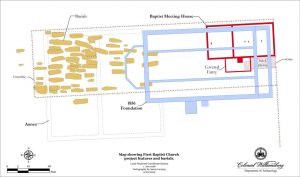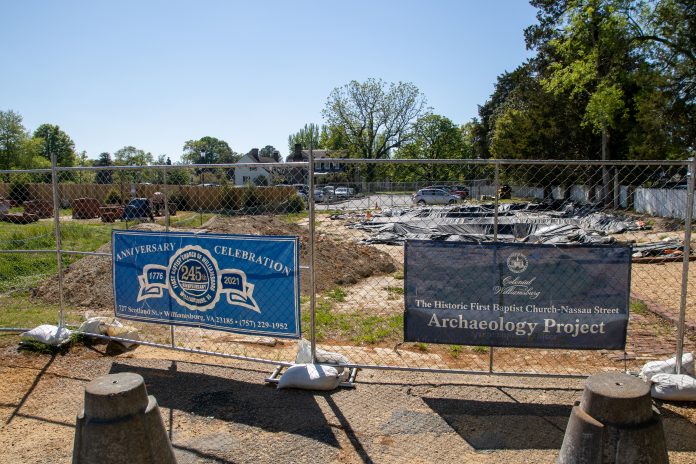Thursday, April 6, archaeologists working on the First Baptist Church Excavation project in Colonial Williamsburg presented their findings on burial sites and human remains found on the grounds of the original First Baptist Church in 2021 at the Williamsburg Stryker Center.
Colonial Williamsburg, the First Baptist Church and Let Freedom Ring Foundation partnered with the Jamestown Rediscovery Foundation in May of 2020 to “conduct ground-penetrating radar,” according to the project’s website. Initial results concluded that the original First Baptist Church site, founded by free and enslaved Black men and women at the start of the American Revolution, had been covered by a parking lot on South Nassau Street in Colonial Williamsburg.
Over the next few years, an excavation project revealed the original foundation of the church as well as evidence of burial sites on the property. In February 2021, members of the First Baptist Church congregation met to agree on the next phase of the project, ultimately deciding to excavate the deceased in order to learn about their identities and properly honor their memory. In July 2022, archaeologists began their excavation of the burial sites and presented their findings to the community at the start of April.

“The First Baptist Church was organized in 1776 by enslaved and free Black people in defiance of laws of the day forbidding the congregation of African Americans,” the Colonial Williamsburg Foundation said a press release .
The physical church site, built in 1856, was purchased by Colonial Williamsburg in 1956 and torn down, with the payment for the land then used to construct the second iteration of the First Baptist Church on Scotland Street.
Member of the First Baptist Church and President of the Let Freedom Ring Foundation Connie Matthews Harshaw spoke about the initial goals of the excavation project.
“The Let Freedom Ring Foundation is a 501(c)(3) nonprofit, we are associated with the historic First Baptist Church, and we are directly responsible for protecting and preserving the historic building and landscape and collecting and preserving artifacts,” Harshaw said. “I say that because we were looking for artifacts on the original site of the First Baptist Church when we met with CW in March of 2020, and we thought if we could just find some of the artifacts on the original site, that would be great.”
Since the initial excavation began, experts from the College of William and Mary, the University of Connecticut and Colonial Williamsburg have completed DNA, osteological and archeological studies of the bodies buried on the site of the original church. Their findings have now proven that the individuals buried on the site are of African descent and many are believed to have constructed the original 1856 church building. Out of 63 confirmed burials, Colonial Williamsburg decided to test the extent of preservation on three deceased individuals.
National Science Foundation postdoctoral fellow at the University of Connecticut Raquel Fleskes aided with the osteological and DNA analysis of the exhumed remains.
“The Virginia area has very high clay soils that are very acidic and very wet, and so those three factors usually lead to poor preservation of human remains,” Fleskes said. “We wanted to make sure that we weren’t going to be uncovering these graves unnecessarily.”
According to Fleskes, out of the three burials tested, burial No. 26 was the best preserved, potentially due to the location of his body which excavators found underneath the foundation of one of the church buildings.
“With burial No. 26, we were able to generate really good DNA data — this individual is male, he has an X and Y chromosome and he is of African descent,” Fleskes said. “These findings are really important because it provides the only definitive estimation of the ancestry of these burials. Because the osteological remains were very poor, they could only very tangentially estimate ancestry affiliation. So the DNA provides that concrete estimate of what population [these individuals] are closely associated with.”
Harshaw emphasized the importance of the input from descendent community members, and the significance of the accomplishments on the property since 2020.
“America has heard the story told by others for a very long time,” Harshaw said. “This is the descendants’ story, and they must have a voice. They must make the decisions about what happens on that site, they must make a decision about anything that’s found on that site. And this was before we knew about intact burials – we needed to make sure we had 100% community and descendent engagement.”
“America has heard the story told by others for a very long time,” Harshaw said. “This is the descendants’ story, and they must have a voice. They must make the decisions about what happens on that site, they must make a decision about anything that’s found on that site. And this was before we knew about intact burials – we needed to make sure we had 100% community and descendent engagement.”

Harshaw mentioned that the team working on this project and partners at the College’s Institute of Historic Biology will be recognized this fall as one of the most successful community engagement efforts currently going on in the United States.
“It is, right now, considered to be the most historically significant archaeological project in the country,” Harshaw said.
“It is, right now, considered to be the most historically significant archaeological project in the country,” Harshaw said. “It was a challenge at first because we had to rebuild trust in the community in Colonial Williamsburg and also the other partners in the community because of the treatment they received during the Jim Crow era. A lot of the descendants that were here then are still alive, so I have to tell you that we have made remarkable progress in improving those relations.”
Colonial Williamsburg Director of Archaeology Jack Gary noted that professor of anthropology Dr. Joseph Jones and NEH professor of anthropology and American studies Dr. Michael Blakey are currently examining some of the bones removed from the site at the IBH. Gary also discussed the significance of this project and the extent of community engagement during his career.
“This is the way that archeology is going right now and others have been championing an approach like this and doing an approach like this, but this is really the first truly community engaged project that we’ve undertaken here at Colonial Williamsburg,” Gary said. “We’re able to build off of others’ work, and it’s one of the reasons why it’s been as successful as it has been. We really do hope to be a model for how this type of work can be done in the future.”
Harshaw, Fleskes and Gary emphasized an overwhelmingly positive response from the descendent community and other partners within Williamsburg and across the nation.
“Everyone understands why we need to be doing this,” Gary said. “We were concerned when we first started the project that we would get a lot of pushback or backlash for doing this, for telling the story, and we really haven’t seen it. It doesn’t really pop up. I think it’s very heartening that the regular person that’s coming to Williamsburg walking down the street has the same reaction to this project that we have to this project, that’s a great feeling.”
Harshaw discussed the next steps for the excavation and community engagement project, and mentioned that many communities across the country are now attempting to begin similar ventures.
“The nation is watching what we’re doing, and we’re getting calls from Montpelier descendents, we’re getting calls from just about every other group, all of these people calling, saying, ‘Wait a minute, how are you guys doing this?’” Harshaw said. “[They say] ‘Tell us what the magic is, how can we follow your example and get this done and bring a community together when the nation, right now, is facing states and governors saying this history is not important?’ Our answer is simply that we’ve got all the right people in the right place at the right time doing good work. Not to oversimplify it, but we always say God is in the mix. This is around faith.”
“The nation is watching what we’re doing, and we’re getting calls from Montpelier descendents, we’re getting calls from just about every other group, all of these people calling, saying, ‘Wait a minute, how are you guys doing this?’” Harshaw said.
Gary considers it a privilege to work with community members and archaeologists in Colonial Williamsburg on this project. He specifically discussed the significance of these partnerships within Colonial Williamsburg.
“To see that level of trust with the members of the community is one of the nice things about this project because it’s no secret here in Williamsburg that the relationship between Colonial Williamsburg and particularly the African-American community has not always been good,” Gary said. “When you add in the descendents perspective, it adds a layer of emotion and humanity to the site.”
Harshaw also emphasized the importance of engaging descendent voices, and mentioned that through this project, excavators have collected thousands of artifacts with plans to display them to the greater community in the next phase of the project. Colonial Williamsburg will not display any human remains or show any images of the deceased out of respect. Plans to reconstruct the First Baptist Church building are in place for 2026, a year that marks the 250th anniversary of both the church and the nation.
“There will be interpreters there, Colonial Williamsburg has gotten two grants which total more than $6 million dollars, we will have programs there on the site,” Harshaw said. “What’s really important is that the graves will not be disturbed. The graves will remain there, the intact burials will remain there. What we have to do now is we have to figure out a way to commemorate those graves.”

